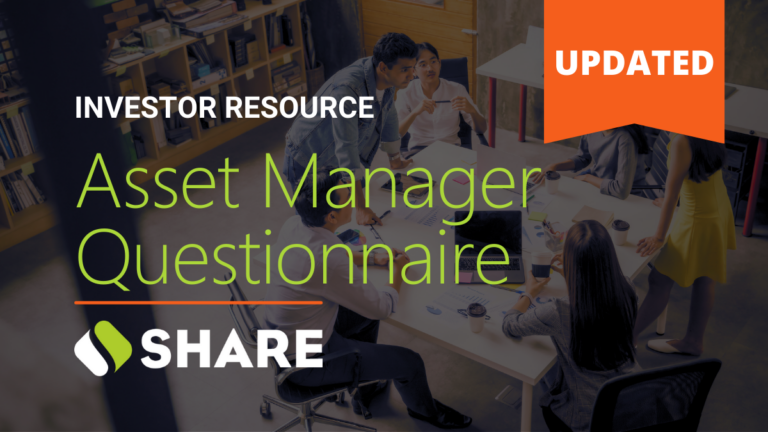The market for investment products labelled as impact, sustainable, responsible, green or ESG (environmental, social and governance) has grown exponentially in recent years as asset owners like foundations are increasingly looking to invest with purpose beyond financial return.
But the authenticity of marketing claims by investment management firms relative to actual investment practices varies significantly.
So how can foundations effectively navigate these investment products to uncover the underlying investment practices and the degree to which they align with their organizations’ missions?
This can feel like a daunting task, and understandably so.
But the role that foundations can play in influencing the investment management industry is actually very exciting. History has shown that the standards expected by mission-driven investors often become market norms.
Nonetheless, there is still a lot of work to do. The biggest risk that impact and responsible investors face is rapid asset growth without the corresponding visible and tangible changes in the real economy that they seek.
So where to start? In this blog, we highlight three areas that we believe warrant more attention from asset owners in the process of evaluating and hiring asset managers. While the three areas are not exhaustive, we highlight them here because we believe they are critical and often overlooked. In a future blog, we’ll focus entirely on the importance of impact measurement and so although that topic will not be covered here, it is an essential piece in ensuring that managers (and our own institutions) are walking the talk.
- Belief Systems
The first area is related to alignment of beliefs. It is often easy to jump directly into an evaluation of what an asset management firm does. Are they an active or a passive manager? Do their funds incorporate multiple asset classes, or do they focus only on fixed income or public equity?
But before jumping into the investment strategy conversation, we recommend that foundations take the time to get to know who the investment management firm is.
What is the firm’s history? What are the firm’s beliefs with regard to the purpose of investing and the relevance of social, economic and environmental factors to the investment process?
Has the firm participated in any public policy processes? If so, what were their contributions to those conversations and did they align with other public statements or commitments the firm has made?
Has the organization signed on to any investor statements related to climate change, just transition, deforestation, or diversity and inclusion? If not, why not? If so, what steps have they taken to implement the statement within their organizations?
For example, the Reconciliation and Responsible Investment Initiative has developed a framework to evaluate the efforts of asset management firms in terms of the steps they are taking to advance reconciliation as set out by the Truth and Reconciliation Commission and specifically Call to Action 92 for the business sector. The objective of this work is to ensure that the firms’ statements in support of reconciliation with Indigenous Peoples are mirrored by the firms’ actions and policies as employers, economic actors, shareholders and capital providers.
- People
The second area meriting further attention from foundations is the firm’s people. Who comprises the senior management team? If the senior management team is made up entirely of white men, is that something your organization is comfortable with?
Another important question to consider is the tone from the top regarding impact and responsible investing. Are they considered leaders in this space? Are they sought after as speakers and in the media for their expertise on impact and ESG investing? How is the firm incentivizing responsible investment leadership? For example, does the variable pay of senior managers incorporate performance related to ESG, such as reducing the carbon footprint across the firm’s portfolios?
At the same time, what in-house expertise do they have on impact and ESG issues? If there is a separate ESG or impact team doing this work, are they empowered to contribute meaningfully to the investment decision-making process?
- Innovation
The third area is around innovation. If foundations seek different outcomes from their investments, then business-as-usual approaches to investment management will not deliver the desired results.
As consumers of asset management services, foundations have a central role to play in incentivizing innovation. If foundations and other values-driven investors are not sending market signals around their expectations for higher standards of impact and ESG funds, then it is unlikely that asset managers will step up in a meaningful way.
A great example of foundations incentivizing innovation can be found in an initiative in the UK called the “ESG Investing Olympics,” started by the Friends Provident Foundation, the Joffe Charitable Trust and the Blagrave Trust. The three participating charities extended an invitation to asset managers to make proposals for the management of funds totaling £32 million.
The charities’ RFP document states, “We wish to bring investment management ‘out of the shadows’ and to this end will be taking a more transparent approach to asset manager selection.”
The shortlisted candidates were invited to present their proposal to an auditorium of trustees, stakeholders and like-minded asset owners. After a 15-minute presentation, each firm responded to questions posed by the charities and a panel of experts. One of the questions put forward to the five short listed candidates was, “Which animal best describes your business and culture?” What a great question to really get to know the manager, as emphasized in the first area that we highlighted above.
Foundation Investing 2.0 looks forward to continuing to work with foundations across Canada to help advance excellence, innovation, collaboration and real-world outcomes in the impact and responsible investing space. Join us at one of our upcoming events and become a part of this growing community.


